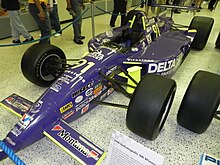
Back إنديانابوليس 500 سنة 1996 Arabic Indianapolis 500 1996 German 500 miles d'Indianapolis 1996 French 1996-os indianapolisi 500 Hungarian 500 Miglia di Indianapolis 1996 Italian Indianapolis 500 in 1996 Dutch 500 Milhas de Indianápolis de 1996 Portuguese Indianapolis 500 1996 Slovenian Indianapolis 500 1996 Swedish
 | |||||
| Indianapolis Motor Speedway | |||||
|---|---|---|---|---|---|
| Indianapolis 500 | |||||
| Sanctioning body | USAC/IRL | ||||
| Season | 1996 IRL season | ||||
| Date | May 26, 1996 | ||||
| Winner | |||||
| Winning team | Hemelgarn Racing | ||||
| Average speed | 147.956 mph | ||||
| Pole position | |||||
| Pole speed | 233.718 mph | ||||
| Fastest qualifier | |||||
| Rookie of the Year | |||||
| Most laps led | |||||
| Pre-race ceremonies | |||||
| National anthem | Florence Henderson | ||||
| "Back Home Again in Indiana" | Jim Nabors | ||||
| Starting command | Mary F. Hulman | ||||
| Pace car | Dodge Viper GTS | ||||
| Pace car driver | Bob Lutz | ||||
| Starter | Duane Sweeney | ||||
| Honorary starter | Robert James Eaton | ||||
| Estimated attendance | 300,000 | ||||
| TV in the United States | |||||
| Network | ABC | ||||
| Announcers | Paul Page, Danny Sullivan, and Bobby Unser | ||||
| Nielsen ratings | 7.1 / 23 | ||||
| Chronology | |||||
| |||||
The 80th Indianapolis 500 was held at the Indianapolis Motor Speedway in Speedway, Indiana on Sunday, May 26, 1996. This was the first Indy 500 contested as part of the new Indy Racing League, under the overall sanctioning umbrella of USAC. It was the third and final race of the 1996 IRL season. Veteran driver and former AIS champion Buddy Lazier won the race, his first career victory in top-level Indy car competition. Lazier's victory came just over two months after he suffered a broken back in a crash at Phoenix. Lazier's victory marks the last (as of 2024) Indy victory for Ford, the second of two all-time victories for Reynard, and was the first victory for Firestone since 1971.
The race was surrounded by months of controversy. Most of the top teams and drivers in Indy car racing chose to boycott the race, protesting a perceived lockout of CART teams by the IRL.[1] Rival teams effectively staged a "walkout" and instead scheduled a competing race the same day, the U.S. 500 at Michigan. The controversy and division surrounding the race became known in racing circles as "The Split". Participants in the 1996 Indy 500 included several familiar Indy car teams and owners such as A.J. Foyt, Dick Simon, Hemelgarn, and Menard. But top teams from CART including Penske, Ganassi, Newman/Haas, Rahal, and many others, were all at Michigan. There were also many new teams, some of which moved up from Indy Lights, AIS, or sports cars. Many of the drivers were inexperienced rookies from an obscure range of backgrounds, giving the impression of a field of replacement drivers.[1] There was only one former Indy 500 winner in the field (Arie Luyendyk), but three former pole position winners entered. In addition, there were no former National Champions in the field for the first time since 1928.
The field was filled to the traditional 33 cars, but only one car was bumped (then-unknown Billy Boat). There was a post-WWII record 17 rookies that qualified, led by reigning USAC Silver Crown/Sprint/Midget champion (and future IRL and NASCAR champion) Tony Stewart. Stewart qualified for the front row, and took home rookie of the year honors. Despite comprising half the field, only two rookies managed to finish in the top ten.
Media attention of the open wheel "Split" was highly critical going into the race, as a number of the IRL participants were ridiculed and the prestige of the Indianapolis 500 itself was brought into question.[1][2] The "split" embittered a significant portion of the fanbase, and journalist Robin Miller of The Indianapolis Star was among the most outspoken of critics. However, the race itself was found to be competitive and entertaining,[1][2] while the rival U.S. 500 suffered a multi-car pile-up prior to the green flag.[1][2]
During practice, the month was marred by the death of pole position winner Scott Brayton, who was killed in a crash testing a back-up car.[1] The month was also plagued by constant rain. In Indianapolis, May 1996 was the fifth-wettest month of May on record, and the 4th wettest month of May in Indy 500 history.[3]
The 1996 race marked Firestone's first Indy 500 victory since 1971. In what would be the final year contested under the turbocharged engine formula (until their reintroduction in 2012), on a newly repaved track,[4] all-time track record speeds were set during practice and time trials. Arie Luyendyk set the official one-lap track record (237.498 mph) and the four-lap track record (236.986 mph), while Eddie Cheever ran the fastest race lap (236.103 mph) in Indy 500 history - records that all still stand as of 2023. Luyendyk also ran the fastest practice lap in Indy history (239.260 mph) just a fraction of a second shy of breaking the 240 mph barrier.
- ^ a b c d e f Hungess, Carl (1996). The 1996 Indianapolis 500 Yearbook. Carl Hungness Publishing. ISBN 0-915088-78-9.
- ^ a b c Cite error: The named reference
Autoweekwas invoked but never defined (see the help page). - ^ "Monthly Temperature and Precipitation Extremes for Indianapolis (1871 to 2008)". NOAA.gov. 2008-06-01. Retrieved 2009-10-28.
- ^ "108 years of Indy 500 history revealed in IMS track sample".
© MMXXIII Rich X Search. We shall prevail. All rights reserved. Rich X Search